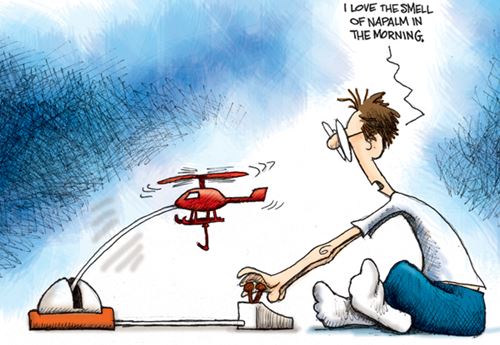Mattel VertiBird
My First Helicopter
by John Salt Updated March 2025
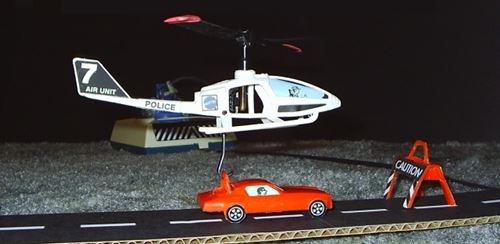 The Mattel VertiBird Is What Began My Life Long Interest In Helicopters
The Mattel VertiBird Is What Began My Life Long Interest In HelicoptersIf you were a kid growing up in the 70's, you most likely remember the Mattel VertiBird. If you had one, you probably consider it one of your favorite, and most memorable toys; at least until the Atari 2600 showed up under the Christmas tree ;-)
The VertiBird was my first ever
helicopter and I can honestly say without question, the little Verti is
what first sparked my interest in helicopters; which of course eventually lead to RC helicopters. It was always a favorite toy for me and my friends to play with after
school.
How many hours we spent flying our VertiBirds around in the
various rumpus rooms in the neighborhood; while reruns of
Gilligan's Island, Brady Bunch, Bewitched, and Star Trek (TOS) were playing in
the background on the old radiation boxes.
Ah, memories...
How Does The Mattel VertiBird Work
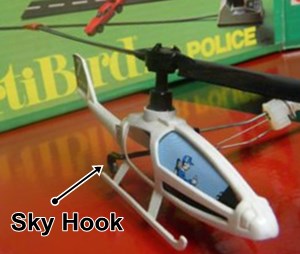
Flying these things is fairly easy. I was only 8 when I got my first one and I don't recall it being all that hard to pilot.
However, learning the fine control skills to use the little hook to pick up, and even harder, successfully drop off little items (in a controlled manner) did take practice and fineness.
Unlike the disposable toy RC helicopters we now have today, Mattel VertiBirds lasted a long time, many of which are still flying today. You could also fly for a couple hours between battery changes. No question, they did eat D batteries, but resourceful kids & their fathers would often tinker together a 6VDC transformer to power them.
The VertiBird consists of three primary components:
1. The Controls 2. The Base 3. The Helicopter
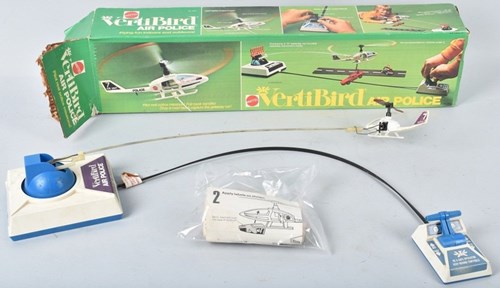 Mattel VertiBird Box Contents
Mattel VertiBird Box ContentsThe controls are very simple.
On the right you have the pitch control lever which would slightly tilt the VertiBird helicopter forward, backward, and of course level for hovering.
The left lever controlled the motor speed which in turn controlled the fixed pitch rotor speed, and thus the amount of lift produced, just like today's fixed pitch toy RC helicopters.
This throttle lever is sprung for safety reasons, and will power off the motor when let go.
Those familiar with flying RC helicopters may have a hard time getting used to the fact that the throttle lever actully powers up when pulled downward, which as you know is completely opposite of the throttle/collective stick on our RC radios.
This does however make lift control easier when pulling down on the sprung stick instead of pushing up. Pulling down/back while flying also prevents the controller from constantly sliding forward toward the base.
The controller is attached to the base unit by way of a somewhat flexible band that contains the two pushrods from both control levers (don't bend this band sharply or the thin metal pushrods inside it will also get bent). One pushrod is attached to the motor speed control within the base, the other is attached to the control turret pitch ring.
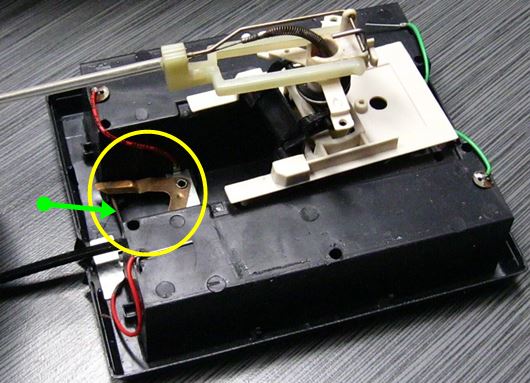 Verti Base With Speed Control Arm (yellow circle) and wire wound resistor (green arrow). The arm position on the resistive windings dictates motor speed.
Verti Base With Speed Control Arm (yellow circle) and wire wound resistor (green arrow). The arm position on the resistive windings dictates motor speed.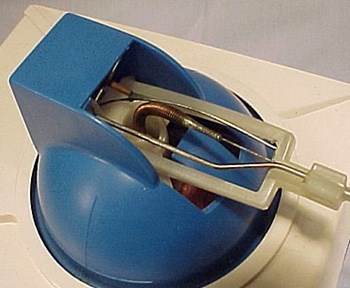 Mattel VertiBird Control Turret
Mattel VertiBird Control TurretThe base is the heart of this toy helicopter.
It contains four "D" size batteries, the motor that spins the helicopter rotor, and most importantly, the control turret (the blue round part).
The turret has a long clear plastic control rod that extends out by about 52 cm or so and is attached to the VertiBird helicopter at the other end.
The Turret is free spinning and by way of the control rod, essentially follows the helicopter as it flies.
The control rod is connected to an articulated arm inside the turret that will pivot up and down dependent on helicopter altitude. This long control rod contains two shafts.
The lower shaft/spindle in the rod is very thin and is what spins the rotor blade on the helicopter. It's attached to the motor shaft, which is dead center in the turret by way of a drive spring (same idea as a flex shaft). This spinning rod is then attached to another drive spring/flex shaft inside the helicopter which in turn spins the rotor shaft.
The other shaft within the rod is larger gauge, and provides the majority of the plastic control rod strength. This shaft (the pitch rod) also provides the pitching control for the helicopter.
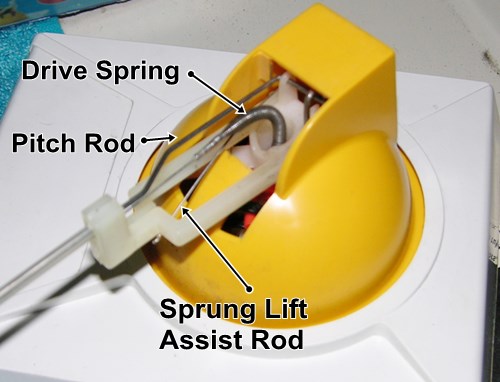 Control Turret Components
Control Turret ComponentsThe above photo shows the location of the drive spring, the pitch rod, and the lift assist rod/spring.
The main purpose of the lift assist rod is to help reduce the amount of weight the little VertiBird heli has to lift. It essentially cancels out the weight of the long control rod mechanism. The other function of this little lift assist rod, is to dampen lift variation from the rotor, giving it much smoother lift control with less oscillation.
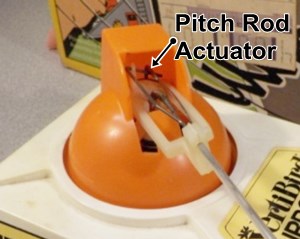
Looking back inside the control turret, we can see the pitch rod actuator arm.
This arm moves up and down when the pitch leaver on the controller is moved, connected by way of a control ring at the base of the turret.
Think of this control ring as a very simple one axis (up/down) swashplate; it connects the non rotating pitch input to the rotating output.
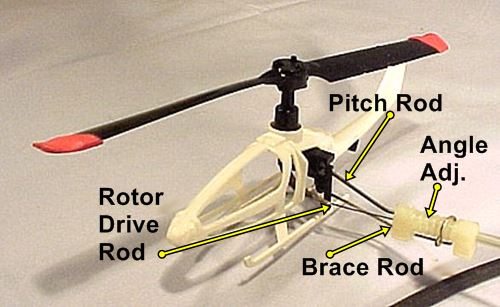 VertiBird Helicopter Control Components
VertiBird Helicopter Control ComponentsFinally onto the Verti Helicopter. Here we can see the other end of the control rod along with the various components.
The brace rod is needed to give the pitch rod something to "work" against as it moves; otherwise the entire plastic control rod would just twist. It also allows you to change the inboard/outboard tilt angle of the helicopter dependent on where it's placed on the angle adjustment hub.
The drive rod/spindle is attached to the rotor drive/flex spring inside the helicopter which is attached to (no surprise) the rotor shaft. Both the drive spring in the turret and in the helicopter allow for angle changes as the helicopter moves up and down, while still spinning the rotor. It's an elegantly simple and lightweight articulated drive method that works so well. Unfortunately, these drive/flex springs tend to be the weakest link of the entire VertiBird, and the most common item to break.
One of two things usually happens; the solder connection between the rod and spring fails, or the spring simply snaps in half.
The spring to rod connection failed on my first Mattel VertiBird after several 8 year old student pilot blade strikes on Christmas morning. I was devastated considering I had been wanting this toy helicopter as much as Ralphie wanted a Red Ryder Carbine-Action Two-Hundred-Shot Range Model Air Rifle! A busted spring may not be as painful as almost shooting your eye out, along with a busted set of glasses; but tears were flowing regardless.
That is when dad came to the rescue and simply re-soldered the spring to the drive shaft. The VertiBird flies again! It's the first time I actually remember taking an interest in soldering as I was amazed such a thing could be done. I soon was hounding dad for soldering lessons in case this horrible inflight failure ever occurred again. Learning to fly and solder all on Christmas day. As Ralphie would say "all was right with the world..."
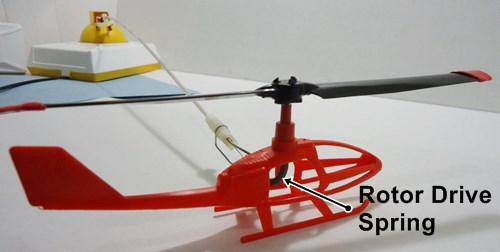 VertiBird Helicopter Drive Spring
VertiBird Helicopter Drive SpringThe rotor drive spring on the heli is usually the one that fails since it's exposed to the greatest torque spike when you have a blade strike. It's the "mechanical fuse" that usually will save the drive spring down in the turret. That said, I recall a couple friends whose turret springs also broke so it can happen. I'm sure dad was thrilled when I eagerly offered up his Verti repair services.
Apparently, the very first Mattel VertiBirds had a screw on spring in the helicopter that threaded onto the drive spindle. This was dropped quickly in favor of the permanent soldered connection, which prevented the spring from unthreading off the spindle during quick spool-downs.
 Mattel VertiBird Rotor Components
Mattel VertiBird Rotor ComponentsTo help save the drive/flex springs, the rotor and rotor hub are also designed to snap apart with high energy rotor impacts. There are three little sprung plastic prongs that snap into three holes in the plastic rotor.
You would think these little prongs would break, but with the two VertiBirds I had over the years, they never did. They did seem to weaken a bit over time however allowing the rotor to snap off a little easier (a good thing for the drive springs).
Likewise the rotors on the VertiBird are next to impossible to break. They are very flexible, and have nice soft vinyl covers over the tips that help absorb a little impact energy, and take the "sting" out of a bare skin rotor strike.
Flying The VertiBird
Some will say the controls of the VertiBird are similar to a real helicopter.
I'm sure after seeing how these things actually work, you realize that is a far stretch at best.
They are nothing like real helicopters. Lift is controlled by rotor speed, not collective pitch angle. There is no cyclic control, and there is no torque reaction to counter because the control rod prevents the helicopter from spinning. There, I just ran off the three primary flight controls of a helicopter, and the Verti has none of them.
With that said, these things are actually flying and will experience some heli specific aerodynamic properties.
For instance, a slight loss of lift will occur when some of the lift vector is pitched forward or backward requiring you to increase throttle a little bit to maintain altitude.
I personally have never felt ground effect with the Vertibird, nor have I experienced translational lift. Too little air movement, and the lift assist spring is no doubt masking any that may be occurring.
So Now You Want To Buy A VertiBird
That's easier said than done!
Mattel produced the VertiBird from 1971 to about 1982; at least here in
North America. I really can't understand why they stopped production?
It's not like there were low cost toy RC helicopters
at the time eating into sales. In my opinion, VertiBirds would have
remained popular right up until 2005 or so when Air Hogs first Havoc (Picoo Z) helicopter was released.
The only thing I can think is Mattel was considering potential liability issues caused by the spinning rotor? Those concerns are however just as real with today's micro RC helicopters.
I know I joked about the Atari 2600 earlier, but perhaps once video game systems started showing up in rumpus rooms, the poor old VertiBirdy was left in a dark corner to collect dust? If so, and if you still have yours, hang on to it! I can only see them going up in price as working ones become more and more rare.
I remember my second VertiBird costing $19.95 CND. I remember because I was saving my allowance for weeks to get it; this one I looked after and still have. Working VertiBirds are now fetching $200 USD and up on eBay.
$300 and more if they are in good condition, complete with box, accessories, and instructions. Mint condition $400 to 500 USD; and I've seen a couple NIB sealed, never opened examples sell for upwards of $3K USD. Even non-working ones are commanding high prices of $100 plus for "parts". The empty boxes alone are fetching $20 bucks or more.
A few Vertibird deals however do show up from time to time on eBay so it pays to keep checking. Garage & estate sales will turn up the best Vertibird finds.
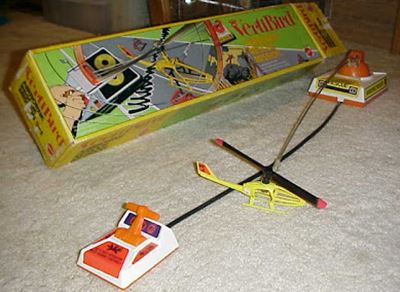 Air Rescue Mattel VertiBird
Air Rescue Mattel VertiBirdWhen you are looking at/for used Mattel Vertibirds, make sure you check or ask about the battery compartment. Like so many battery operated toys from this era, crappy batteries in them often leaked out. This is not reason to walk away from an otherwise good and working Verti.
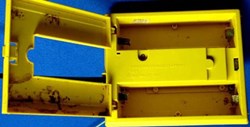 VertiBird Corroded Battery Compartment
VertiBird Corroded Battery CompartmentAs long as the base was not sitting upside down when the batteries leaked out (ie. no acid leaked up into the turret or motor), the damage should be confined to the contact terminals and the battery cover hatch as shown here.
If you are somewhat handy, the terminal/s can be either be cleaned up with a rotatory tool fine sanding drum/similar, or you may have to solder new ones in if they are really thin or even partially dissolved. Battery leakage can be a good bargaining chip if you have the skill to clean/repair it.
Another item to look at/for on used VertiBirds is the little sky hook. It's often snapped up inside the tail boom so when out of sight, you may forget to even look to see if it's actually there. These hooks are another common breakage item and are often busted or missing. Missing ones are easily spotted if the photo of the heli is clear. The black hook pins mount into a hole right above each rear landing strut. If you don't see a little black dot above each rear landing strut, the hook is not there.
Used hooks do surface from time to time (for outrageous amounts of money). Unless you are looking for a collector piece, you can easily make hooks. I recall after breaking mine, my dad helped me make replacements from thin aluminum sheet. If you have or know of someone with a 3D printer, you could "print out" a few replacement hooks.
Again, a missing hook is not reason to pass up an otherwise nice Verti find, it's another good bargaining chip.
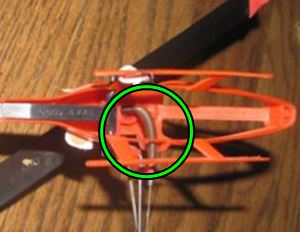 Ensure Drive Springs Are Not Broken
Ensure Drive Springs Are Not BrokenThe show stopper of any used VertiBird is if it has a broken Drive Spring (Flex Shaft); either on the helicopter or in the base control turret.
As I mentioned before, if the solder between the spring and drive shaft has simply failed, that is easy to repair by re-soldering them back together.
If however the spring has snapped in half, that would be reason to walk away unless you are looking for a Verti parts project only.
I've searched high and low for replacement Verti drive springs and for the life of me, I can't find a single one out there. It might be possible to find similar sized tiny flex shafts but I honestly don't know of anything that will work. Most flex shafts are heavy, larger, and stronger for tool type applications.
If anyone does know of a VertiBird replacement drive spring source, I would very much like to know.
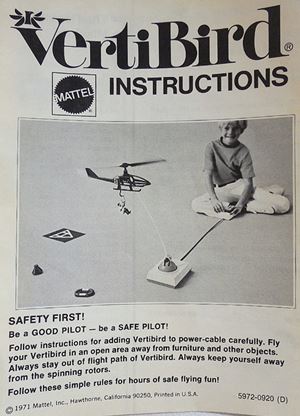 Even The Manuals Are Selling For Upwards Of $20 Bucks!
Even The Manuals Are Selling For Upwards Of $20 Bucks!VertiBird Versions
Over and above the basic Air Police and Air Rescue versions I and so many others had, Mattel offered the VertiBird in a dozen or so versions over the years. Here's a link to Wikipedia's Mattel Vertibird page which does a good job listing most, if not all of them.
Below are just a few examples:
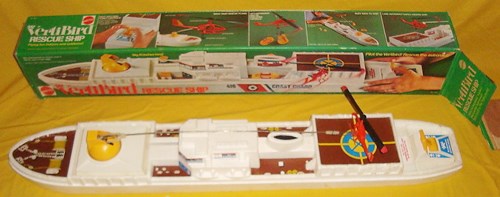 VertiBird Rescue Ship
VertiBird Rescue Ship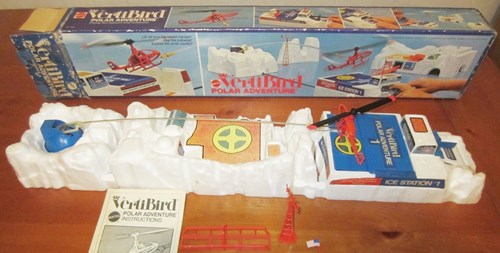 VertiBird Polar Adventure
VertiBird Polar Adventure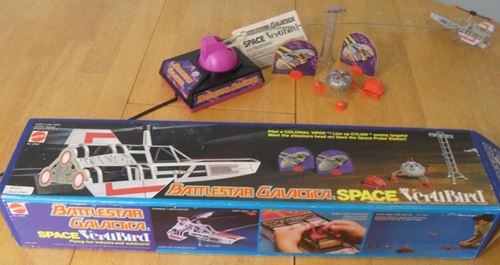 VertiBird Battlestar Galactica
VertiBird Battlestar Galactica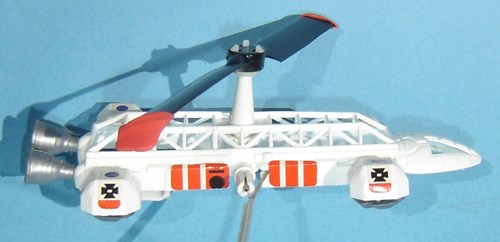 VertiBird Space 1999
VertiBird Space 1999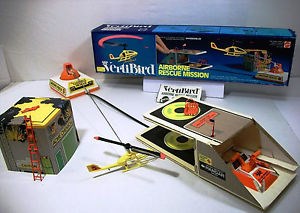 VertiBird Airborne Rescue Mission
VertiBird Airborne Rescue Mission The Very Rare Okanagan Logging Vertibird
The Very Rare Okanagan Logging VertibirdAs a Canadian who lives in British Columbia, the unicorn Vertibird find for me is without doubt, the crazy rare Okanagan Logging Copter version. I don't how many of these were made and sold, but to say they are scarce is an understatement. I can't even imagine what one in good condition with the original box is worth!
If by chance anyone has one and wants to share images of it to include on this page (I won't even ask if you want to sell it as I know I couldn't afford it), feel free to contact me.
Hope my little VertiBird page here brought back some fond memories from the 70's and gave you some useful information if you chose to look for a used one somewhere.
This was a fun page to write. Whoever says you can't travel backward in time, never flew a VertiBird most likely ;-)
Fun Visitor Feedback
Your Mattel Vertibird read was very nice. I felt compelled to let
you know where it all started for me. Before your time I had a toy
called Marx-A-Copter. Not as sophisticated as the Vertibird but the idea was the same. I also had the Remco Whirlybird. It didn't fly, but the rotors would spin. It was really cool. There was also a TV series, called Whirlybirds (1957 - 1960). Those Star Trek, Bewitched, Gilligan Island shows where likely first run episodes for me.
Thanks for the memories,
Michael - United States
